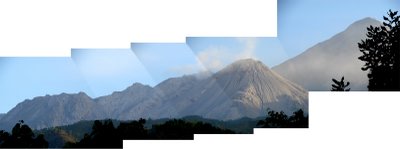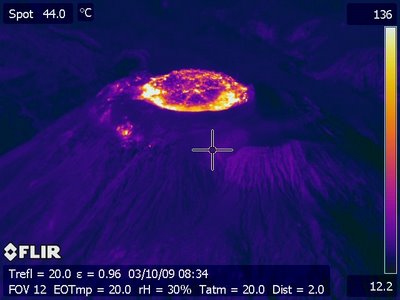27 March 2009
Santiaguito lava dome complex
Posted by Jessica Ball
 If seeing this first thing in the morning doesn’t both make you want to jump up and down in excitement AND say, “Oh, shit, I just spent the entire night unconscious and three klicks away from an erupting volcano,” you are either clinically dead or an alien.
If seeing this first thing in the morning doesn’t both make you want to jump up and down in excitement AND say, “Oh, shit, I just spent the entire night unconscious and three klicks away from an erupting volcano,” you are either clinically dead or an alien.
 A composite of Santiaguito, gently steaming in the 6AM sunlight. This is both a fascinating and depressing time – fascinating because I could see a volcano erupt for a few hours, but depressing because at this point I had already been up and dealing with thermal imaging equipment for an hour, sans food or drink thanks to my recovering stomach.
A composite of Santiaguito, gently steaming in the 6AM sunlight. This is both a fascinating and depressing time – fascinating because I could see a volcano erupt for a few hours, but depressing because at this point I had already been up and dealing with thermal imaging equipment for an hour, sans food or drink thanks to my recovering stomach.Santiaguito is a strange place. The first of the lava domes in the complex, Caliente (the one erupting in the first photo, and the farthest to the right in the one above) began extruding from the 1902 eruption crater in Santa Maria in 1922. By 1929, the year that a 3 million cubic meter collapse and pyroclastic surge occurred, the dome had grown to about half a cubic kilometer in size. In the next 80 or so years, the other three domes – La Mitad, El Monje, and El Brujo – formed as the active vent migrated westward.
Then, after a brief period when both Caliente and El Brujo were active, everything shifted back to Caliente. Currently, Caliente is looking more and more like a mini-stratovolcano – the old rubbly dome has long since been covered over by talus slopes and lava flows. At the summit, however, is a very strange situation. The main vent consists of two structures: an outer ring-shaped fracture set, and an “inner annulus”, or smaller ring-shaped vent. During an eruption, jets of gas and ash are expelled from various points around these rings, and the both rings heat up. In addition, the eruptions are pushing out a blocky, viscous lava flow onto the SW slope of Caliente.
 A Forward-Looking InfraRed (FLIR) view of the top of Caliente from the summit of Santa Maria. The outer ring is clearly visible as a bright, hot area, and there are radial fractures leading to the “inner annulus”, which is somewhat harder to see. The pinkish patch on the opposite side of the dome summit is the lava flow, and there are several fumaroles below the summit on the near side. Temperatures are in Celsius, and brighter colors mean the surface is hotter.
A Forward-Looking InfraRed (FLIR) view of the top of Caliente from the summit of Santa Maria. The outer ring is clearly visible as a bright, hot area, and there are radial fractures leading to the “inner annulus”, which is somewhat harder to see. The pinkish patch on the opposite side of the dome summit is the lava flow, and there are several fumaroles below the summit on the near side. Temperatures are in Celsius, and brighter colors mean the surface is hotter. A clip from a FLIR video of an eruption. The lava flow is clearly visible on the left side of the dome, and several jets are apparent in the eruption plume. These eruptions last for several minutes, and it’s common to see the hot jets of ash and gas migrate around the ring fracture.
A clip from a FLIR video of an eruption. The lava flow is clearly visible on the left side of the dome, and several jets are apparent in the eruption plume. These eruptions last for several minutes, and it’s common to see the hot jets of ash and gas migrate around the ring fracture.Caliente’s eruptions occur every few hours. That’s right – not days, or weeks, or months – hours. It’s amazing to watch, and even more incredible to listen to, because these eruptions sound exactly like a jet flying overhead. (Interestingly enough, people looking at infrasound – way below human hearing range – have found that volcanoes sound like jet engines there, too.) Occasionally these eruptions are large enough to produce pyroclastic flows, which eventually expand and drift and turn into a really annoying, view-blocking cloud around the base of the volcano.
 This particular eruption, on the 15th of March, got reported in the local news the next day. The eruption plume, which came from both the vent and the pyroclastic flow on Caliente’s SW slope, drifted to the SE, toward a number of small towns, rather than to the SW, which is where it usually goes and where there are mostly coffee plantations. It’s not unusual to see ash coating coffee plants when you’re driving through the fincas, although it seems that the nearby towns don’t see it that often.
This particular eruption, on the 15th of March, got reported in the local news the next day. The eruption plume, which came from both the vent and the pyroclastic flow on Caliente’s SW slope, drifted to the SE, toward a number of small towns, rather than to the SW, which is where it usually goes and where there are mostly coffee plantations. It’s not unusual to see ash coating coffee plants when you’re driving through the fincas, although it seems that the nearby towns don’t see it that often.
Another interesting feature of eruptions is that they are often preceded and followed by rockfalls. These are really easy – and neat – to watch on infrared camera, and sometimes you can hear the cracking of house-sized blocks tumbling down the slopes. They’re likely from the front of the lava flow, where oversteepened blocks are detached by the push of extrusion or just the shaking of the eruption itself.
It’s really amazing to see all this activity happening all the time. What’s surprising is that the monitoring abilities at the Santiaguito Volcano Observatory are really limited. There are several observers on staff all the time, but they don’t receive any telemetered data from the instruments on the volcano – it all goes straight to Guatemala City. This limits them to, basically, what they can see out the back door – and after about 10 in the morning, even in the dry season, that isn’t much. I suspect this results in the number and height of eruptions being underreported, since even if you can hear something going on (sometimes possible) when the volcano is covered in clouds, you can’t see it. It also makes for some pretty anxious moments, like when you realize just how screwed you really are if you’re within a few km of the domes
and something big happens.
Still, the observatory folks do a great job with what they have. And getting to the observatory isn’t easy, either – it either takes an hour of walking up and down some very big hills over a narrow road, or a really bumpy ride in the back of a pickup (if you’re lucky enough to catch a ride in with the finca workers at 6:30 in the morning). Coffee, however, is readily available, since the observatory sits right in the middle of a field of coffee bushes, and the finca office is right down the road. (Interestingly enough, this finca is owned by Starbucks, so those of you geologists with a taste for expensive coffee can be assured that your daily grind has been raised on the finest volcanic ash Santiaguito can produce.)
Next up: a visit to the valleys below the volcano, and a little bit about the 1929 pyroclastic surge.
Bibliography:
Bluth, G.J.S., Rose, W.I. (2004): Observations of Volcanic Activity at Santiaguito Volcano, Guatemala. J. Volcanol. Geotherm. Res. 136:297-302.
Harris, A.J.L., Rose, W.I., Flynn, L.P. (2003): Temporal Trends in Lava Dome Extrusion at Santiaguito, 1922-2000. Bull. Volcanol. 65:77-89.
Johnson, J.B., Harris, A.J.L., Sahetapy-Engel, S.T.M., Wolf, R., Rose, W.I. (2004): Explosion Dynamics of Pyroclastic Eruptions at Santiaguito Volcano. Geophysical Research Letters 31:L06610.
Rose, W.I. (1972a): Santiaguito Volcanic Dome, Guatemala. Geol. Soc. Am. Bull. 83:1413-1434.
Rose, W.I. (1973): Pattern and Mechanism of Volcanic Activity at the Santiaguito Volcanic Dome, Guatemala. Bull. Volcanol. 37:73-94.
Rose, W.I. (1987b): Volcanic Activity at Santiaguito Volcano, 1976-1984. Spec. Pap. Geol. Soc. Am. 212:101-111.
Rose, W.I., Stoiber, R.E., Bonis, S.B. (1970): Volcanic Activity at Santiaguito Volcano, Guatemala June 1968 – August 1969. Bull. Volcanol. 34:295-307.
Rose, W.I., Pearson, T., Bonis, S. (1977): Nuee Ardente Eruption from the Foot of a Dacite Lava Flow, Santiaguito Volcano, Guatemala. Bull. Volcanol. 40:23-38.
Sahetapy-Engel, S.T.M., Flynn, L.P., Harris, A.J.L., Bluth, G.J., Rose, W.I., Matias, O. (2004): Surface Temperature and Spectral Measurements at Santiaguito Lava Dome, Guatemala. Geophys. Res. Lett. 31:L19610.
Williams, S.N., Self, S. (1983): The October 1902 Plinian Eruption of Santa Maria Volcano, Guatemala. J. Volcanol. Geotherm. Res. 16:33-56.


 Jessica Ball is a volcanologist at the U.S. Geological Survey, researching volcanic hydrothermal systems and stability, and doing science communication for the California Volcano Observatory. She previously worked at the Geological Society of America's Washington DC Policy Office, learning about the intersection of Earth science and legislative affairs. Her Mendenhall postdoc and PhD focused on how water affects the stability of volcanoes, and involved both field investigations and numerical modeling applications. Her blogging covers a range of topics, from her experiences in academic geosciences to science outreach and communication to her field and lab work in volcanology.
Jessica Ball is a volcanologist at the U.S. Geological Survey, researching volcanic hydrothermal systems and stability, and doing science communication for the California Volcano Observatory. She previously worked at the Geological Society of America's Washington DC Policy Office, learning about the intersection of Earth science and legislative affairs. Her Mendenhall postdoc and PhD focused on how water affects the stability of volcanoes, and involved both field investigations and numerical modeling applications. Her blogging covers a range of topics, from her experiences in academic geosciences to science outreach and communication to her field and lab work in volcanology.
Great stuff, Jess! I was going to ask about the composition of the domes, but I found it in Google Earth via the Smithsonian/USGS Volcanoes layer.Were there any photos of the domes prior to the 1929 collapse? I imagine that’d be awfully useful to a study like yours.
There are a couple; I’ve got copies, and I was going to write them into the next post. There are also dome profiles that Karl Sapper did, although I can’t remember if they’re pre- or post-collapse.It is definitely cool stuff. Hopefully the next time I go back I’ll be in better shape to appreciate it! (It still blows my mind that I’m going to be climbing those domes, though.)
WOW never have I seen the infrared view of a Volcanoe before, I study comets and I see the view al the time when deciding the make up etc of comets. just awesome.
[…] the next time that we hear about Santa Maria in accounts like this is in 1929, when part of the Santiaguito lava dome collapsed. I’ll talk about those in another […]
[…] accounts of the 1902 eruption of Santa Maria in Guatemala. As all of you probably know by now, the Santiaguito lava dome complex started growing in the 1902 eruption crater in 1922. At first there was just one dome (which was […]